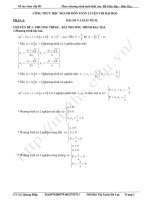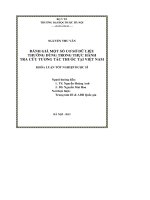Sổ tay tra cứu tương tác thuốc ppt
Bạn đang xem bản rút gọn của tài liệu. Xem và tải ngay bản đầy đủ của tài liệu tại đây (769.73 KB, 69 trang )
MED
facts
POCKET GUIDE OF
DRUG INTERACTIONS
Second Edition
MED
facts
POCKET GUIDE OF
DRUG INTERACTIONS
Second Edition
Provided as an
Educational
Service by
Provided as an
Educational
Service by
MED
facts
This drug interactions pocket guide was written on behalf of Nephrology
Pharmacy Associates, Inc. (NPA) by George R. Bailie, PharmD, PhD,
Curtis A. Johnson, PharmD, Nancy A. Mason, PharmD, and
Wendy L. St. Peter, PharmD, BCPS.
NPA acknowledges the assistance of Fangyan Sy, PharmD.
POCKET GUIDE OF
DRUG INTERACTIONS
Second Edition
Disclaimer
These drug interaction guidelines are offered as a general summary of
information for physicians, pharmacists, nurses and other health professionals.
Inappropriate administration of interacting drugs to patients can result in severe
injury or death. These guidelines cannot identify medical risks specific to an
individual patient or recommend patient treatment. These guidelines are not to
be used as a substitute for professional training. The absence of typographical
errors is not guaranteed. These guidelines are not necessarily all-inclusive.
Use of these guidelines indicates acknowledgement that neither Nephrology
Pharmacy Associates, Inc. (NPA), Bone Care International, Inc. nor the
authors will be responsible for any loss or injury, including death, sustained
in connection with, or as a result of, the use of these guidelines. Readers should
consult the complete information available in the package insert for each agent
indicated before prescribing medications.
Guides such as this one can only draw from information available at the time
of publication. Nephrology Pharmacy Associates, Inc., Bone Care International,
Inc. and the authors of these guidelines are under no obligation to update
information obtained herein. Future medical advances or product information
may affect or change the information provided. Health professionals using these
guidelines are responsible for monitoring ongoing medical advances related to
drug therapy.
Copyright 2004. All rights reserved, including right of reproduction, in whole or in
part, in any form.
2 / MEDFACTS POCKET GUIDE OF DRUG INTERACTIONS
MEDFACTS POCKET GUIDE OF DRUG INTERACTIONS / 3
Preface
Patients with acute renal failure, chronic kidney disease (CKD) or those treated
with dialysis or kidney transplantation are frequently prescribed numerous
medications. Drugs of many therapeutic classes are used to treat the underlying
diseases leading to CKD, such as diabetes mellitus and hypertension, while
others are used to control or treat the common complications of CKD, such
as anemia, renal bone disease and lipid disorders. Dialysis patients often are
prescribed 10 to 12 medications. With such a large number of medications, there
is an increased risk for drug interactions. The accompanying table has been
prepared as a reference regarding the most clinically significant drug
interactions that might occur, together with an indication of the possible
consequence. This table should be used as a general guideline.
Sometimes information is known about one specific drug within a certain drug
class, while additional information is not known about other agents within the
same therapeutic category. Clinicians must be aware of this possibility and use
their best judgement when prescribing or assessing drug therapy.
Types of Drug Interactions
Drug interactions are often classified as either pharmacodynamic or
pharmacokinetic interactions. Pharmacodynamic interactions include those
that result in additive or antagonistic pharmacological effects. Pharmacokinetic
interactions involve induction or inhibition of metabolizing enzymes in the liver or
elsewhere, displacement of drug from plasma protein binding sites, alterations
in gastrointestinal absorption, or competition for active renal secretion.
The frequency and prevalence of interactions is dependent upon the number
of concomitant medications and the complexity of the regimens. The prevalence
is also dependent upon other variables, such as patient adherence, hydration
and nutritional status, degree of renal or hepatic impairment, smoking and
alcohol use, genetics and drug dosing. Additionally, some patients may exhibit
evidence of a particular drug interaction, while others with the same drug
combination do not.
Pharmacodynamic interactions
This type of interaction will not be addressed in this reference, since these
should be reasonably easy to predict, knowing the pharmacology of any
given drug.
Pharmacokinetic interactions
Interactions Resulting from Alterations in Gastrointestinal Absorption
The rate and extent of drug absorption after oral administration may be grossly
altered by other agents. Absorption of a drug is a function of the drug’s ability to
diffuse from the lumen of the gastrointestinal tract into the systemic circulation.
Changes in intestinal pH may profoundly affect drug diffusion as well as
dissolution of the dosage form. For example, the absorption of ketoconazole
is reduced by the co-administration of antacids or H
2
-blockers (e.g. ranitidine,
famotidine) that reduce the extent to which the ketoconazole tablet is dissolved.
Formation of insoluble complexes by a process known as chelation is another
mechanism by which a drug interaction may lead to reduced oral absorption.
For example, fluoroquinolones (e.g. ciprofloxacin) and divalent metal ions
(such as calcium and iron) form an insoluble complex that results in reduced
absorption of both the antibiotic and the metal ion. Interactions that decrease
the rate of drug absorption may be of little importance, since the overall extent
of absorption may remain unaltered.
Interactions Resulting from Alterations in Metabolizing Enzymes
The liver is the major, though not exclusive, site for drug metabolism. Other sites
include the kidney and the lining of the gastrointestinal tract. The two main types
of hepatic drug metabolism are phase I and phase II reactions. Phase I oxidative
reactions are the initial step in drug biotransformation, and are mediated by the
cytochrome P-450 (CYP) system. This complex superfamily of enzymes has been
subclassified into numerous enzymatic subfamilies. The most common CYP
subfamilies include CYP1A2, CYP2C9, CYP2C19, CYP2D6, CYP2E1, and CYP3A4.
These enzymes may be induced or inhibited by other agents, thereby leading
to an increase or decrease in the metabolism of the primary drug. Phase II
reactions occur following Phase I reactions. In this process, drug metabolites
are converted into more water-soluble compounds that can be more easily
eliminated by the kidneys.
4 / MEDFACTS POCKET GUIDE OF DRUG INTERACTIONS
MEDFACTS POCKET GUIDE OF DRUG INTERACTIONS / 5
Enzyme induction may result in increased CYP enzyme synthesis, faster drug
metabolism, subtherapeutic drug concentrations and the risk for ineffective drug
therapy. The rapidity of the enzyme induction is dependent upon the half-life of
the inducing drug as well as the rate of synthesis of new enzymes. Examples of
drugs that cause enzyme induction are the barbiturates, some anticonvulsants
and rifampin.
Enzyme inhibition may result from noncompetitive or competitive inhibition
of CYP enzymes by a second drug, an effect that may occur rapidly. Examples
of hepatic enzyme inhibitors include cimetidine, fluconazole and erythromycin.
The result of noncompetitive enzyme inhibition by addition of a second agent
is slower metabolism of the first drug, higher plasma drug concentrations, and
a risk for toxicity. In the case of competitive inhibition, the metabolism of both
drugs can be reduced, resulting in higher than expected concentrations of
each drug.
A few drugs are metabolized by enzymes found in cells lining the
gastrointestinal tract. One of these drugs is cyclosporine. Some foods and
other preparations such as grapefruit juice contain certain substances that
may inhibit those specific enzymes, resulting in elevated serum cyclosporine
concentrations.
Interactions Resulting from Alterations in Protein Binding
Drugs may exist in plasma either reversibly bound to plasma proteins or in the
free (unbound) state. The primary drug-binding plasma proteins are albumin
and α
1
-acid glycoprotein. It is free drug that exerts the pharmacological effect.
Drugs may compete with each other for plasma protein binding sites, and when
this occurs, one drug may displace another that was previously bound to the
protein. Displacement of a drug from its binding sites will therefore increase
that agent’s unbound concentrations, perhaps resulting in toxicity.
Some drugs normally exist in a state of high protein binding, often exceeding
90%. Thus, even a small decrease in protein binding could significantly increase
the free concentrations. Drugs which are normally highly protein bound,
and which might participate in binding interactions, include anticonvulsants
and warfarin.
Interactions Resulting from Changes in Renal Excretion
The majority of renally eliminated drugs are excreted via passive glomerular
filtration. Some drugs are eliminated via active tubular secretion, such as
penicillins, cephalosporins, and most diuretics. The active secretion may
be inhibited by secondary agents, such as cimetidine, nonsteroidal anti-
inflammatory agents and probenecid, with resulting elevations in the serum drug
concentrations and reduced urinary drug concentrations. In some cases, the
interaction is desirable, while others may lead to adverse therapeutic outcomes.
Risk Factors and Management of Drug
Interactions
In general, the more complex a patient’s drug regimen, the higher the risk for
interactions. CKD patients often take numerous medications. The average age
of a dialysis patient is over 60 years and as a group, elderly patients are more
prone to experience drug interactions because of reduced hepatic and renal
function. Identification of the potential for interactions may enable the clinician
to avoid its occurrence. Drugs that require careful dose titration to maintain
efficacy and avoid toxicity must be monitored particularly carefully for drug
interactions. Most drug interactions can be avoided or managed by substitution
of one or more agents or more intense monitoring for the potential result.
Other management strategies include separation of doses of interacting agents
(e.g. ciprofloxacin and calcium) or prospective adjustment of doses.
Clinical Significance of Interactions
This guide lists only those interactions that have been previously rated as having
a moderate or high level of clinical significance by the Drug Interaction Facts
(see References). This rating scale requires that a potential interaction has
a moderate to major severity. The effects of a moderate interaction may cause
a deterioration in the patient's clinical status, resulting in additional treatment,
hospitalization, and/or an extended hospital stay. The effects of a major interac-
tion are potentially life-threatening or can lead to permanent damage. In addition
to being clinically significant, the interaction must be reasonably documented in
the literature (suspected, probable, or established). Therefore, the accompanying
table is NOT an all-inclusive list of every possible drug interaction.
6 / MEDFACTS POCKET GUIDE OF DRUG INTERACTIONS
MEDFACTS POCKET GUIDE OF DRUG INTERACTIONS / 7
Key to the Table
The accompanying table contains four columns. The first is titled “Drug,” and
lists the primary drugs and drug classes, by generic name, which may have a
significant interaction. The drugs are listed according to therapeutic classes.
The second column is titled “Interacting Drug,” and lists drugs or drug classes
that have potential clinically significant interactions with the primary listed
drugs. These two columns are cross-referenced, as appropriate.
The third column, “Potential Effect,” gives a short description of the possible
clinical outcome of the interaction. The outcomes listed are possible, not
definite, events. Clinicians must be aware that not all patients will manifest
these interactions.
The last column, “Management,” indicates suggested strategies for prevention,
monitoring, and managing any potential interactions. If combination therapy
of interacting drugs cannot be avoided, the patient should be advised of any
potential adverse effects. Always monitor the patient for any changes in clinical
response when starting, stopping, or changing the dose of interacting drugs.
Also monitor for any signs/symptoms of known toxicities. Appropriate clinical
intervention should be taken when necessary.
References and Additional Reading
Further information about the listings in the table may be found in reference
number 1. Additional readings are listed for the convenience of the reader.
1. Tatro DS (ed). Drug Interaction Facts 2004. Facts and Comparisons, St. Louis,
MO, 2004.
2. Stockley IH, Drug Interactions, 5th ed. London: Pharmaceutical Press; 1999.
3. Landrum EL. Update: clinically significant cytochrome P-450 drug interactions.
Pharmacotherapy 1998; 18:84-112.
MEDFACTS POCKET GUIDE OF DRUG INTERACTIONS / 9
ANEMIA AGENTS
Androgens
Nandrolone decanoate
Warfarin, see Anticoagulants/Thrombolytic Agents—Androgens
Methyltestosterone/
Cyclosporine, see Transplant Immunosuppressants—Androgens
Testosterone
Warfarin, see Anticoagulants/Thrombolytic Agents—Androgens
Epoetin Alfa No interactions noted.
Iron Products
Iron Salts (IV)
Chloramphenicol Increased concentrations Use alternative antibiotic if
[iron dextran, of iron. possible. Otherwise, monitor
ferric gluconate, iron stores and adjust iron
iron sucrose] replacement as needed.
Iron Salts (Oral)
Chloramphenicol Increased concentrations. Use alternative antibiotic if
[ferrous fumarate,
of iron. possible. Otherwise monitor
ferrous gluconate,
iron stores and adjust iron
ferrous sulfate,
replacement as needed.
iron polysaccharide]
Levodopa, see Antiparkinson Agents
Levothyroxine, see Miscellaneous Agents
Mycophenolate mofetil, see Transplant Immunosuppressants
Penicillamine Decreased GI absorption Administer penicillamine on
of penicillamine. an empty stomach. Separate
administration times.
Phosphate Binders/Antacids Decreased GI absorption of iron. Separate administration
[aluminum hydroxide, times.
aluminum-magnesium
hydroxide, calcium acetate,
calcium carbonate,
magnesium hydroxide]
Quinolones, see Antimicrobial Agents (Antibacterial Antibiotics)
Tetracyclines, see Antimicrobial Agents (Antibacterial Antibiotics)
ANTIHYPERTENSIVE AND CARDIOVASCULAR AGENTS
Adrenergic Modifiers
Clonidine
Beta-Blockers [acebutolol, Increased blood pressure. Monitor blood pressure
atenolol, betaxolol, carteolol, when starting or stopping
esmolol, metoprolol, nadolol, either drug. Discontinue
penbutolol, pindolol, either drug gradually.
propranolol, timolol]
Tricyclic Antidepressants Loss of blood pressure control. Avoid combination.
[amitriptyline, amoxapine, Increased risk of
clomipramine, desipramine, hypertensive crisis.
doxepin, imipramine,
nortriptyline, protriptyline,
trimipramine]
Methyldopa
Sympathomimetics Increased blood pressure. Monitor blood pressure.
[dobutamine, dopamine, Discontinue
ephedrine, epinephrine, sympathomimetic or
mephentermine, administer phentolamine
metaraminol, methoxamine, if necessary.
norepinephrine,
phenylephrine,
pseudoephedrine]
Prazosin
Beta-Blockers [acebutolol, Increased postural hypotension. Monitor for symptoms
atenolol, betaxolol, bisoprolol, of postural hypotension.
carteolol, esmolol,
metoprolol, nadolol,
penbutolol, pindolol,
propranolol, sotalol, timolol]
Verapamil Increased postural hypotension. Monitor for symptoms
of postural hypotension.
Angiotensin Benazepril, Captopril, Enalapril, Fosinopril, Lisinopril, Moexipril,
Converting Enzyme Perindopril, Quinapril, Trandolapril
Inhibitors (ACEIs)
Angiotensin
Indomethacin Decreased effects of angiotensin Monitor blood pressure.
Converting Enzyme
converting enzyme inhibitor. Discontinue indomethacin
Inhibitors-class
or use alternative
antihypertensive.
Lithium, see Sedative/Hypnotics/Agents used in Psychiatry, Antidepressants
(Miscellaneous Antidepressants)
Potassium-Sparing Diuretics Elevated serum potassium. Monitor serum potassium.
[amiloride, spironolactone,
triamterene]
Captopril
(see also Food Decreased GI absorption Administer captopril
Angiotensin Converting of captopril. 1 hour before meals.
Enzyme Inhibitors-class)
Angiotensin II Candesartan, Eprosartan, Irbesartan, Losartan, Olmesartan, Telmisartan,
Receptor Blockers Valsartan
(ARBs)
Angiotensin II
Lithium, see Sedative/Hypnotics/Agents used in Psychiatry, Antidepressants
Receptor Blockers-
(Miscellaneous Antidepressants)
class
Beta-Blockers Cardio-Selective [Acebutolol, Atenolol, Betaxolol, Bisoprolol, Esmolol,
Metoprolol, Nadolol]; Noncardio-Selective [Carteolol, Carvedilol,
Labetalol, Penbutolol, Pindolol, Propranolol, Sotalol, Timolol]
Cardio-Selective and
Barbiturates [amobarbital, Decreased bioavailability of Increase beta-blocker dose
Noncardio-Selective
aprobarbital, butabarbital, beta-blocker. if necessary.
Beta-Blockers-class
butalbital, mephobarbital,
pentobarbital, phenobarbital,
primidone, secobarbital]
Cimetidine Increased concentrations of Monitor cardiovascular
beta-blocker. status. Decrease beta-
blocker dose if necessary.
Clonidine, see Antihypertensive and Cardiovascular Agents (Adrenergic Modifiers)
Hydralazine Increased concentrations of both Decrease dose of one or
drugs (metoprolol, propranolol). both drugs if necessary.
NSAIDs [ibuprofen, Decreased effects of Use noninteracting NSAID
indomethacin, naproxen, beta-blocker. if possible (eg, sulindac).
piroxicam] Monitor blood pressure.
Increase beta-blocker dose
if necessary.
Prazosin, see Antihypertensive and Cardiovascular Agents (Adrenergic Modifiers)
10 / MEDFACTS POCKET GUIDE OF DRUG INTERACTIONS
DRUG INTERACTING DRUG POTENTIAL EFFECT MANAGEMENT
Propafenone Increased effects of Monitor cardiovascular
beta-blocker status. Decrease beta-
(metoprolol, propanolol). blocker dose if necessary.
Quinidine Increased effects of beta- Monitor cardiovascular
blocker (atenolol, propranolol, status. Decrease beta-
metoprolol, timolol). blocker dose if necessary.
Rifamycins Decreased effects of beta- Monitor cardiovascular
[rifabutin, rifampin] blocker (atenolol, bisoprolol, status. Increase
metoprolol, propranolol). beta-blocker dose
if necessary.
Verapamil Increased effects of Monitor cardiovascular
both drugs. status. Decrease dose of one
or both drugs if necessary.
Noncardio-Selective
Epinephrine, see Antihypertensive and Cardiovascular Agents
Beta-Blockers-class
(Miscellaneous Antihypertensive and Cardiovascular Agents)
Ergot Alkaloids, see Miscellaneous Agents
Insulin, see Hypoglycemic Agents
Prazosin, see Antihypertensive and Cardiovascular Agents (Adrenergic Modifiers)
Theophylline, see Bronchodilators
Atenolol
(see also Ampicillin Decreased effects of atenolol. Separate administration
Cardio-Selective and times. Monitor blood
Noncardio-Selective pressure. Increase atenolol.
Beta-Blockers-class) dose if necessary.
Carvedilol
(see also Cyclosporine, see Transplant Immunosuppressants
Cardio-Selective and
Noncardio-Selective
Beta-Blockers-class)
Labetalol
(see also Inhalation Anesthetics Excessive hypotension. Monitor blood pressure. Use
Cardio-Selective and [desflurane, enflurane, combination with caution.
Noncardio-Selective halothane, isoflurane, Halothane concentration
Beta-Blockers-class) sevoflurane] should not exceed 3%.
Metoprolol
(see also Lidocaine, see Antihypertensive and Cardiovascular Agents (Antiarrhythmic Agents)
Cardio-Selective and
Noncardio-Selective
Beta-Blockers-class)
Thioamines [methimazole, Increased effects of metoprolol. Monitor cardiovascular
propylthiouracil] status. Decrease metoprolol
dose if necessary as patient
becomes euthyroid. Use
alternative beta-blocker
(eg, atenolol, nadolol).
Nadolol
(see also Lidocaine, see Antihypertensive and Cardiovascular Agents (Antiarrhythmic Agents)
Cardio-Selective and
Noncardio-Selective
Beta-Blockers-class)
Pindolol
(see also Lidocaine, see Antihypertensive and Cardiovascular Agents (Antiarrhythmic Agents)
Cardio-Selective and
Noncardio-Selective
Beta-Blockers-class)
Phenothiazines Increased effects of one Decrease dose of one or
[chlorpromazine, thioridazine] or both drugs. both drugs if necessary.
MEDFACTS POCKET GUIDE OF DRUG INTERACTIONS / 11
DRUG INTERACTING DRUG POTENTIAL EFFECT MANAGEMENT
Propranolol
(see also Lidocaine, see Antihypertensive and Cardiovascular Agents (Antiarrhythmic Agents)
Cardio-Selective and
Noncardio-Selective
Beta-Blockers-class)
Phenothiazines Increased effects of one Decrease dose of one or
[chlorpromazine, thioridazine] or both drugs. both drugs if necessary.
Thioamines [methimazole, Increased effects of propranolol. Monitor cardiovascular
propylthiouracil] status. Decrease propranolol
dose if necessary as patient
becomes euthyroid. Use
alternative beta-blocker
(eg, atenolol, nadolol).
Sotalol
(see also Quinolones [gatifloxacin, Increased risk of cardiac Avoid combination.
Cardio-Selective and moxifloxacin, sparfloxacin] arrhythmias, including Use alternative quinolones
Noncardio-Selective torsades de pointes. (eg, ciprofloxacin,
Beta-Blockers-class) levofloxacin).
Calcium-Channel Amlodipine, Bepridil, Diltiazem, Felodipine, Isradipine, Nicardipine,
Blockers (CCBs) Nifedipine, Nimodipine, Nisoldipine, Verapamil
Bepridil
Digoxin, see Antihypertensive and Cardiovascular Agents
(Miscellaneous Antihypertensive and Cardiovascular Agents)
Quinolones [gatifloxacin, Increased risk of cardiac Avoid combination.
moxifloxacin, sparfloxacin] arrhythmias, including Use alternative quinolones
torsades de pointes. (eg, ciprofloxacin,
levofloxacin).
Ritonavir Increased concentrations Avoid combination.
of bepridil.
Diltiazem
Benzodiazepines, see Sedatives/Hypnotics/Agents used in Psychiatry (Sedatives)
Carbamazepine Increased concentrations Monitor carbamazepine
of carbamazepine. concentrations. Adjust dose
as needed when starting
or stopping diltiazem.
Cyclosporine, see Transplant Immunosuppressants
HMG-CoA Reductase Inhibitors, see Hypolipidemic Agents
Moricizine Increased concentrations Adjust dose of one or both
of moricizine. drugs as needed.
Decreased concentrations
of diltiazem.
Quinidine, see Antihypertensive and Cardiovascular Agents (Antiarrhythmic Agents)
Sirolimus, see Transplant Immunosuppressants
Tacrolimus, see Transplant Immunosuppressants
Theophyllines Increased concentrations Monitor theophylline
[aminophylline, of theophylline. concentrations. Adjust
oxtriphylline, theophylline] theophylline dose as
needed when starting or
stopping diltiazem.
Felodipine
Barbiturates [amobarbital, Decreased effects of felodipine. Monitor cardiovascular
aprobarbital, butabarbital, status. Increase felodipine
butalbital, mephobarbital, dose if necessary.
pentobarbital, phenobarbital,
primidone, secobarbital]
Carbamazepine Decreased effects of felodipine. Monitor cardiovascular
status. Increase felodipine
dose if necessary.
12 / MEDFACTS POCKET GUIDE OF DRUG INTERACTIONS
DRUG INTERACTING DRUG POTENTIAL EFFECT MANAGEMENT
Erythromycin Increased effects of felodipine. Monitor cardiovascular
status. Decrease felodipine
dose if necessary.
Grapefruit Juice Increased effects of felodipine. Avoid combination.
Hydantoins [ethotoin, Decreased effects of felodipine. Monitor cardiovascular
fosphenytoin, mephenytoin, status Increase felodipine
phenytoin] dose if necessary.
Itraconazole Increased effects of felodipine. Monitor cardiovascular
status Decrease felodipine
dose if necessary.
Nicardipine
Cyclosporine, see Transplant Immunosuppressants
Nifedipine
Barbiturates [amobarbital, Decreased effects of nifedipine. Monitor cardiovascular
aprobarbital, butabarbital, status. Increase nifedipine
butalbital, mephobarbital, dose if necessary.
pentobarbital, phenobarbital,
primidone, secobarbital]
Cimetidine Increased effects of nifedipine. Adjust nifedipine dose
as needed when starting,
stopping, or changing
dose of cimetidine. Use
alternative histamine
H
2
-antagonist (eg, ranitidine).
Rifampin Decreased effects of nifedipine. Monitor cardiovascular
status. Adjust nifedipine
dose as needed when
starting or stopping rifampin.
Tacrolimus, see Transplant Immunosuppressants
Nisoldipine
Grapefruit Juice Increased effects of nisoldipine. Avoid combination.
Hydantoins [ethotoin, Decreased effects of nisoldipine. Monitor cardiovascular
fosphenytoin, mephenytoin, status. Adjust nisoldipine
phenytoin] dose when starting, stopping,
or changing dose
of hydantoin.
Verapamil
Beta-Blockers, see Antihypertensive and Cardiovascular Agents
(Cardio-Selective and Noncardio-Selective Beta-Blockers)
Calcium Salts [calcium Reverse clinical effects and Monitor cardiovascular
acetate, calcium carbonate, toxicities of verapamil. status. Calcium may be
calcium chloride, calcium used to reverse verapamil
citrate, calcium glubionate, toxicities.
calcium gluconate, calcium
glycerophosphate, calcium
lactate, calcium levulinate,
tricalcium phosphate]
Carbamazepine, see Anticonvulsants
Cyclosporine, see Transplant Immunosuppressants
Digoxin Increased concentrations Monitor cardiovascular
of digoxin. status and digoxin
concentrations. Decrease
digoxin dose if necessary.
Ethanol, see Miscellaneous Agents
HMG-CoA Reductase Inhibitors, see Hypolipidemic Agents
MEDFACTS POCKET GUIDE OF DRUG INTERACTIONS / 13
DRUG INTERACTING DRUG POTENTIAL EFFECT MANAGEMENT
Nondepolarizing Muscle Increased nondepolarizing Avoid combination if possible.
Relaxants [atracurium, muscle relaxant effects Monitor respiratory function.
doxacurium, mivacurium, (prolonged respiratory Adjust nondepolarizing
pancuronium, pipecuronium, depression). muscle relaxant dose
tubocurarine, vecuronium] as needed.
Prazosin, see Antihypertensive and Cardiovascular Agents (Adrenergic Modifiers)
Quinidine, see Antihypertensive and Cardiovascular Agents (Antiarrhythmic Agents)
Rifampin Decreased effects of Use intravenous verapamil
oral verapamil. or alternative drug. Adjust
verapamil dose as needed
when starting or stopping
rifampin.
Antiarrhythmic Agents
Amiodarone
Cyclosporine, see Transplant Immunosuppressants
Digoxin, see Antihypertensive and Cardiovascular Agents
(Miscellaneous Antihypertensive and Cardiovascular Agents)
Fentanyl Increased risk of profound Avoid combination if possible.
bradycardia, sinus arrest, Otherwise, monitor
and hypotension. hemodynamic status and
manage with supportive
treatment as needed.
Hydantoins [ethotoin, Increased concentrations of Monitor cardiovascular
fosphenytoin, mephenytoin, hydantoin. status and for signs/
phenytoin] Decreased concentrations of symptoms of hydantoin
amiodarone. toxicity. Adjust dose of one
or both drugs as needed.
Procainamide, see Antihypertensive and Cardiovascular Agents (Antiarrhythmic Agents)
Protease Inhibitors Increased concentrations Avoid combination.
[indinavir, ritonavir] of amiodarone.
Quinidine, see Antihypertensive and Cardiovascular Agents (Antiarrhythmic Agents)
Quinolones [gatifloxacin, Increased risk of cardiac Avoid combination.
moxifloxacin, sparfloxacin] arrhythmias, including Use alternative quinolones
torsades de pointes. (eg, ciprofloxacin,
levofloxacin).
Warfarin, see Anticoagulants/Thrombolytic Agents
Disopyramide
Hydantoins [ethotoin, Decreased concentrations Monitor cardiovascular
fosphenytoin, mephenytoin, of disopyramide. Increased risk status and anticholinergic
phenytoin] of anticholinergic effects. effects. Increase
disopyramide dose if
necessary.
Quinolones [gatifloxacin, Increased risk of cardiac Avoid combination.
moxifloxacin, sparfloxacin] arrhythmias, including Use alternative quinolones
torsades de pointes. (eg, ciprofloxacin,
levofloxacin).
Rifampin Decreased concentrations Monitor cardiovascular
of disopyramide. status. Increase
disopyramide dose if
necessary.
Flecainide
Ritonavir Increased concentrations Avoid combination.
of flecainide.
14 / MEDFACTS POCKET GUIDE OF DRUG INTERACTIONS
DRUG INTERACTING DRUG POTENTIAL EFFECT MANAGEMENT
Lidocaine
Beta-Blockers [atenolol, Increased concentrations Administer bolus lidocaine
metoprolol, nadolol, of lidocaine. at a slow rate to avoid high
pindolol, propranolol] peak concentrations and
toxicity. Monitor lidocaine
concentrations. Decrease
lidocaine dose if necessary.
Cimetidine Increased concentrations Monitor lidocaine
of lidocaine. concentrations. Decrease
lidocaine dose if necessary.
Use alternative histamine H
2
-
antagonist (eg, ranitidine).
Mexiletine
Hydantoins [ethotoin, Decreased concentrations Monitor cardiovascular
fosphenytoin, mephenytoin, of mexiletine. status. Increase mexiletine
phenytoin] dose if necessary.
Theophylline, see Bronchodilators
Moricizine
Cimetidine Increased concentrations Monitor ECG when starting,
of moricizine. stopping, or changing dose
of cimetidine. Decrease
moricizine dose if necessary.
Use alternative histamine H
2
-
antagonist (eg, ranitidine).
Procainamide
Amiodarone Increased concentrations Monitor serum procainamide
of procainamide and and N-acetylprocainamide
N-acetylprocainamide. concentrations. Decrease
procainamide dose
if necessary.
Cimetidine Increased concentrations Avoid combination if possible.
of procainamide and Otherwise, decrease
N-acetylprocainamide procainamide dose
if necessary.
Ofloxacin Increased concentrations Monitor serum procainamide
of procainamide. concentrations. Decrease
procainamide dose
if necessary.
Quinolones [gatifloxacin, Increased risk of cardiac Avoid combination.
moxifloxacin, arrhythmias, including Use alternative quinolones
sparfloxacin] torsades de pointes. (eg, ciprofloxacin,
levofloxacin).
Trimethoprim Increased concentrations Monitor serum procainamide
of procainamide and and N-acetylprocainamide
N-acetylprocainamide. concentrations. Decrease
procainamide dose
if necessary.
Propafenone
Quinidine Increased concentrations Monitor cardiovascular
of propafenone. status. Decrease
propafenone dose or extend
dosing interval if necessary.
Ritonavir Increased concentrations Avoid combination.
of propafenone.
Quinidine
Amiloride Increased risk of cardiac Avoid combination if
arrhythmias and reversal of possible. Otherwise,
quinidine effects. closely monitor ECG.
MEDFACTS POCKET GUIDE OF DRUG INTERACTIONS / 15
DRUG INTERACTING DRUG POTENTIAL EFFECT MANAGEMENT
Amiodarone Increased concentrations Avoid combination if
of quinidine. Increased risk possible. Otherwise, monitor
of cardiac arrhythimas. quinidine concentrations
and decrease quinidine dose
if necessary.
Barbiturates [amobarbital, Decreased concentrations Monitor quinidine
aprobarbital, butabarbital, of quinidine concentrations. Adjust
butalbital, mephobarbital, quinidine dose as needed
pentobarbital, phenobarbital, when starting, stopping,
primidone, secobarbital] or changing dose
of barbiturate.
Cimetidine Increased concentrations Avoid combination.
of quinidine. if possible. Otherwise,
monitor quinidine
concentrations and
decrease quinidine dose
if necessary.
Codeine, see Pain Medications (Narcotic)
Digoxin, see Antihypertensive and Cardiovascular Agents
(Miscellaneous Antihypertensive and Cardiovascular Agents)
Diltiazem Increased concentrations Monitor cardiovascular
of quinidine. status and quinidine
concentrations. Adjust
quinidine dose as needed
when starting or
stopping diltiazem.
Hydantoins [fosphenytoin, Decreased concentrations Monitor quinidine
phenytoin] of quinidine. concentrations. Increase
quinidine dose if necessary.
Itraconazole Increased concentrations Monitor quinidine
of quinidine. concentrations. Decrease
quinidine dose if necessary.
Phosphate Binders/Antacids Increased concentrations Monitor quinidine
[aluminum hydroxide, of quinidine. concentrations. Decrease
aluminum-magnesium quinidine dose if necessary.
hydroxide,
magnesium hydroxide,
sodium bicarbonate]
Propafenone, see Antihypertensive and Cardiovascular Agents (Antiarrhythmic Agents)
Quinolones [gatifloxacin, Increased risk of cardiac Avoid combination.
moxifloxacin, sparfloxacin] arrhythmias, including Use alternative quinolones
torsades de pointes. (eg, ciprofloxacin,
levofloxacin).
Rifamycins Decreased concentrations Monitor quinidine
[rifabutin, rifampin] of quinidine. concentrations when
starting, stopping, or
changing dose of rifamycin.
Adjust quinidine dose
as needed.
Ritonavir Increased concentrations Avoid combination.
of quinidine.
16 / MEDFACTS POCKET GUIDE OF DRUG INTERACTIONS
DRUG INTERACTING DRUG POTENTIAL EFFECT MANAGEMENT
Verapamil Increased concentrations Avoid combination if possible.
of quinidine. Otherwise, monitor
Increased risk of cardiac cardiovascular status and
arrhythimas and hypotension. quinidine concentrations.
Stop one or both drugs if
interaction develops and
treat symptomatically.
Warfarin, see Anticoagulants/Thrombolytic Agents
Nitrates Amyl Nitrite, Isosorbide Dinitrate, Isosorbide Mononitrate, Nitroglycerin
Nitrates-class
Ergot Alkaloids, see Miscellaneous Agents
Phosphodiesterase-5 Severe hypotension. Avoid combination.
Enzyme Inhibitors [sildenafil,
tradalafil, vardenafil]
Nitroglycerin
Alteplase (tPA) Decreased effects of tPA. Avoid combination.
Miscellaneous Antihypertensive and Cardiovascular Agents
Digoxin
Aminoglycosides [kanamycin, Decreased concentrations Monitor digoxin
neomycin, paromomycin] of digoxin. concentrations. Increase
digoxin dose if necessary.
Amiodarone Increased concentrations Monitor digoxin
of digoxin. concentrations and for
signs/symptoms of digoxin
toxicity. Decrease digoxin
dose if necessary.
Antineoplastic Agents Decreased concentrations Monitor digoxin
[bleomycin, carmustine, of digoxin. concentrations.
cyclophosphamide, Increase digoxin dose
cytarabine, doxorubicin, if necessary.
methotrexate, vincristine]
Bepridil Increased concentrations Monitor cardiovascular
of digoxin. Increased status. Decrease digoxin
negative chronotropic effects. dose if necessary.
Cholestyramine Decreased concentrations Separate administration
of digoxin. times. Monitor for decreased
digoxin effects. Increase
digoxin dose if necessary.
Cyclosporine Increased concentrations Monitor digoxin
of digoxin. concentrations and for
signs/symptoms of digoxin
toxicity. Decrease digoxin
dose if necessary.
Indomethacin Increased concentrations Monitor digoxin
of digoxin in concentrations and for
premature infants. signs/symptoms of digoxin
toxicity. Decrease
digoxin dose if necessary.
Itraconazole Increased concentrations Monitor digoxin
of digoxin in concentrations and for
premature infants. signs/symptoms of digoxin
toxicity. Decrease
digoxin dose if necessary.
MEDFACTS POCKET GUIDE OF DRUG INTERACTIONS / 17
DRUG INTERACTING DRUG POTENTIAL EFFECT MANAGEMENT
Loop Diuretics [bumetanide, Increased risk of arrhythmias. Monitor serum potassium and
ethacrynic acid, magnesium concentrations.
furosemide] Supplement electrolytes
if necessary. Restrict dietary
and sodium intake or use
potassium-sparing diuretics.
Macrolide Antibiotics Increased concentrations Monitor digoxin
[clarithromycin, of digoxin. concentrations and for
erythromycin] signs/symptoms of digoxin
toxicity. Decrease digoxin
dose if necessary.
Metoclopramide Decreased concentrations Monitor for decreased
of digoxin. digoxin effects. Increase
digoxin dose if necessary.
Penicillamine Decreased concentrations Monitor digoxin
of digoxin. concentrations and for
signs/symptoms of digoxin
toxicity. Increase digoxin
dose if necessary.
Propafenone Increased concentrations Monitor digoxin
of digoxin. concentrations and for
signs/symptoms of digoxin
toxicity. Decrease digoxin
dose if necessary.
Quinidine Increased concentrations Monitor digoxin
of digoxin. concentrations and for
signs/symptoms of digoxin
toxicity. Decrease digoxin
dose if necessary.
Quinine Increased concentrations Monitor digoxin
of digoxin. concentrations and for
signs/symptoms of digoxin
toxicity. Decrease digoxin
dose if necessary.
Spironolactone Decreased inotropic effects. Monitor for decreased
digoxin effects. Increase
digoxin dose if necessary.
Tetracyclines Increased concentrations Monitor digoxin
[demeclocycline, of digoxin. concentrations and for
doxycycline, minocycline, signs/symptoms of digoxin
oxytetracycline, tetracycline] toxicity. Decrease digoxin
dose if necessary.
Thiazide Diuretics Increased risk of arrhythmias. Monitor serum potassium and
[bendroflumethiazide, magnesium concentrations.
chlorothiazide, Supplement electrolytes if
chlorthalidone, necessary. Restrict dietary
hydrochlorothiazide, and sodium intake or use
hydroflumethiazide, potassium-sparing diuretics.
indapamide,
methyclothiazide,
metolazone, polythiazide,
trichlormethiazide]
Thioamines [methimazole, Increased concentrations Monitor digoxin
propylthiouracil] of digoxin. concentrations and for
signs/symptoms of digoxin
toxicity. Decrease digoxin
dose if necessary.
18 / MEDFACTS POCKET GUIDE OF DRUG INTERACTIONS
DRUG INTERACTING DRUG POTENTIAL EFFECT MANAGEMENT
Thyroid Hormones Decreased concentrations Increase digoxin dose
[levothyroxine, liothyronine, of digoxin if necessary in hypothyroid
liotrix, thyroid] patients if they become
euthyroid.
Verapamil Increased concentrations Monitor digoxin
of digoxin concentrations and for signs/
symptoms of digoxin toxicity.
Decrease digoxin dose if
necessary.
Epinephrine
Beta-Blockers [carteolol, Initial hypertensive episode, Avoid combination if possible.
nadolol, penbutolol, pindolol, followed by reflex bradycardia. Discontinue beta-blocker
propranolol, timolol] 3 days prior to epinephrine
use if possible. Otherwise,
monitor vital signs and use IV
chlorpromazine, IV
hydralazine, IV aminophylline,
and/or IV atropine if
necessary.
Hydralazine
Beta-Blockers, see Antihypertensive and Cardiovascular Agents
(Cardio-Selective and Noncardio-Selective Beta-Blockers)
ANTIMICROBIAL AGENTS
ANTIBACTERIAL ANTIBIOTICS
Aminoglycosides Amikacin, Gentamicin, Kanamycin, Neomycin, Streptomycin, Tobramycin
Aminoglycosides-class
Cephalosporins Increased risk of nephrotoxicity. Monitor aminoglycoside
[cefamandole, cefazolin, concentrations and
cefonicid, cefoperazone, kidney function.
cefotaxime, cefotetan,
cefoxitin, ceftazidime,
ceftizoxime, ceftriaxone,
cefuroxime, cephalothin,
cephapirin, cephradine]
Digoxin, see Antihypertensive and Cardiovascular Agents
(Miscellaneous Antihypertensive and Cardiovascular Agents)
Loop Diuretics [bumetanide, Increased risk Avoid excessive doses of
ethacrynic acid, of auditory toxicity. either drug. Monitor
furosemide, torsemide] aminoglycoside
concentrations. Use
alternative antibiotic
if possible.
NSAIDs [diclofenac, Increased concentrations of Avoid combination if possible.
etodolac, fenoprofen, aminoglycoside in premature Otherwise, decrease
flubiprofen, ibuprofen, infants. aminoglycoside dose before
indomethacin, ketoprofen, starting NSAID. Monitor
ketorolac, meclofenamate, aminoglycoside
mefenamic acid, concentrations and renal
nabumetone, naproxen, function.
oxaprozin, piroxicam,
sulindac, tolmetin]
Penicillins [ampicillin, Inactivation of Do not mix drugs in same
methicillin, mezlocillin, aminoglycoside. solution. Separate
nafcillin, oxacillin, administration times by at
penicillin G, piperacillin, least 2 hours.
ticarcillin]
MEDFACTS POCKET GUIDE OF DRUG INTERACTIONS / 19
DRUG INTERACTING DRUG POTENTIAL EFFECT MANAGEMENT
Cephalosporins Cefamandole, Cefazolin, Cefonicid, Cefoperazone, Cefotaxime, Cefotetan,
Cefoxitin, Ceftazidime, Ceftizoxime, Ceftriaxone, Cefuroxime, Cephalothin,
Cephapirin, Cephradine
Cephalosporins-class
Aminoglycosides, see Antimicrobial Agents (Antibacterial Antibiotics)
Warfarin, see Anticoagulants/Thrombolytic Agents
Cefamandol
(see also Ethanol, see Miscellaneous Agents
Cephalosporins-class)
Cefonicid
(see also Ethanol, see Miscellaneous Agents
Cephalosporins-class)
Cefoperazone
(see also Ethanol, see Miscellaneous Agents
Cephalosporins-class)
Ceforanide
(see also Ethanol, see Miscellaneous Agents
Cephalosporins-class)
Cefotetan
(see also Ethanol, see Miscellaneous Agents
Cephalosporins-class)
Moxalactam
(see also Ethanol, see Miscellaneous Agents
Cephalosporins-class)
Macrolide Azithromycin, Clarithromycin, Erythromycin, Troleandomycin
Antibiotics
Macrolide
Cyclosporine, see Transplant Immunosuppressants
Antibiotics-class
HMG-CoA Reductase Inhibitors, see Hypolipidemic Agents
Theophylline, see Bronchodilators
Clarithromycin
Buspirone, see Sedatives/Hypnotics/Agents used in Psychiatry (Miscellaneous Sedatives)
(see also Macrolide
Antibiotics-class)
Carbamazepine, see Anticonvulsants
Digoxin, see Antihypertensive and Cardiovascular Agents
(Miscellaneous Antihypertensive and Cardiovascular Agents)—Macrolide Antibiotics
Ergot Alkaloids, see Miscellaneous Agents— Macrolide Antibiotics
Rifamycins [rifabutin, Decreased effects of Monitor for increased
rifampin, rifapentine] clarithromycin. Increased rifamycin adverse effects and
adverse effects of rifamycin. decreased response to
macrolide antibiotic. Use
alternative antibiotic (eg,
azithromycin, dirithromycin).
Tacrolimus, see Transplant Immunosuppressants— Macrolide Antibiotics
Warfarin, see Anticoagulants/Thrombolytic Agents—Macrolide Antibiotics
Erythromycin
Benzodiazepines, see Sedatives/Hypnotics/Agents used in Psychiatry (Sedatives)
(see also Macrolide
Antibiotics-class)
Bromocriptine Increased concentrations Monitor for signs/symptoms
of bromocriptine. of bromocriptine toxicity.
Decrease bromocriptine
dose if necessary.
Buspirone, see Sedatives/Hypnotics/Agents used in Psychiatry (Miscellaneous Sedatives)—
Macrolide Antibiotics
Carbamazepine, see Anticonvulsants—Macrolide Antibiotics
20 / MEDFACTS POCKET GUIDE OF DRUG INTERACTIONS
DRUG INTERACTING DRUG POTENTIAL EFFECT MANAGEMENT
Digoxin, see Antihypertensive and Cardiovascular Agents (Miscellaneous Antihypertensive and
Cardiovascular Agents)—Macrolide Antibiotics
Ergot Alkaloids, see Miscellaneous Agents—Macrolide Antibiotics
Felodipine, see Antihypertensive and Cardiovascular Agents (Calcium-Channel Blockers)
Food Decreased GI absorption Administer erythromycin
of erythromycin. stearate and non-enteric
tablets at least 2 hours
before or after a meal.
Grapefruit Juice Increased concentrations of Avoid combination.
erythromycin.
Methylprednisolone, see Corticosteroids
Quinolones [gatifloxacin, Increased risk of cardiac Avoid combination. Use
moxifloxacin, sparfloxacin] arrhythmias, including alternative quinolones (eg,
torsades de pointes. ciprofloxacin, levofloxacin).
Rifamycins Decreased effects of Monitor for increased
[rifabutin, rifampin] erythromycin Increased rifamycin adverse effects and
adverse effects of rifamycin. decreased response to
macrolide antibiotic. Use
alternative antibiotic (eg,
azithromycin, dirithromycin).
Tacrolimus, see Transplant Immunosuppressants—Macrolide Antibiotics
Warfarin, see Anticoagulants/Thrombolytic Agents—Macrolide Antibiotics
Penicillins Amoxicillin, Ampicillin, Bacampicillin, Carbenicillin, Cloxacillin,
Dicloxacillin, Methicillin, Mezlocillin, Penicillin G, Penicillin V,
Piperacillin, Ticarcillin
Penicillins-class
Aminoglycosides, see Antimicrobial Agents (Antibacterial Antibiotics)
Food Decreased or delayed GI Administer penicillin at least
absorption of oral penicillins. 2 hours before or after a
meal.
Methotrexate, see Antineoplastic Agents
Tetracyclines Decreased effects of penicillins. Avoid combination.
[demeclocycline,
doxycycline, minocycline,
oxytetracycline, tetracycline]
Warfarin, see Anticoagulants/Thrombolytic Agents
Ampicillin
(see also Allopurinol Increased rate of ampicillin- Decrease allopurinol dose or
Penicillins-class) associated skin rash. use alternative drug if rash
develops.
Atenolol Decreased effects of atenolol. Separate administration
times. Monitor blood
pressure. Increase atenolol
dose if necessary.
Quinolones Ciprofloxacin, Gatifloxacin, Gemifloxacin, Levofloxacin, Lomefloxacin,
Moxifloxacin, Nalidixic Acid, Norfloxacin, Ofloxacin, Sparfloxacin,
Trovafloxacin
Quinolones-class
Didanosine Decreased GI absorption Administer didanosine at
of quinolone. least 6 hours before or 2
hours after quinolone
MEDFACTS POCKET GUIDE OF DRUG INTERACTIONS / 21
DRUG INTERACTING DRUG POTENTIAL EFFECT MANAGEMENT
Iron Salts (Oral) Decreased GI absorption Avoid combination.
[ferrous fumarate, ferrous of quinolone.
gluconate, ferrous sulfate,
iron polysaccharide]
Phosphate Binders/Antacids Decreased GI absorption Separate administration
[aluminum hydroxide, of quinolone. times by at least 2 hours.
aluminum-magnesium
hydroxide, calcium acetate,
calcium carbonate,
magnesium hydroxide]
Sucralfate Decreased GI absorption Administer sucralfate at
of quinolone. least 6 hours after quinolone.
Ciprofloxacin
(see also Cyclosporine, see Transplant Immunosuppressants—Quinolones
Quinolones-class)
Food [milk] Decreased GI absorption Avoid combination.
of ciprofloxacin.
Theophylline, see Bronchodilators—Quinolones
Norfloxacin
(see also Cyclosporine, see Transplant Immunosuppressants—Quinolones
Quinolones-class)
Food [milk] Decreased GI absorption Avoid combination.
of norfloxacin.
Theophylline, see Bronchodilators—Quinolones
Ofloxacin
(see also Procainamide, see Antihypertensive and Cardiovascular Agents (Antiarrhythmic Agents)
Quinolones-class)
Sparfloxacin
(see also Amiodarone, see Antihypertensive and Cardiovascular Agents (Antiarrhythmic Agents)
Quinolones-class)
Bepridil Increased risk of cardiac Avoid combination.
arrhythmias, including torsades
de pointes.
Disopyramide, see Antihypertensive and Cardiovascular Agents (Antiarrhythmic Agents)
Erythromycin, see Antimicrobial Agents, Antibacterial Antibiotics (Macrolide Antibiotics)
Phenothiazines, see Sedatives/Hypnotics/Agents used in Psychiatry (Antipsychotic Agents)
Procainamide, see Antihypertensive and Cardiovascular Agents (Antiarrhythmic Agents)
Quinidine, see Antihypertensive and Cardiovascular Agents (Antiarrhythmic Agents)
Sotalol, see Antihypertensive and Cardiovascular Agents (Beta-Blockers)
Tricyclic Antidepressants, see Sedatives/Hypnotics/Agents used in Psychiatry
(Tricyclic Antidepressants)
Tetracyclines Demeclocycline, Doxycycline, Methacycline, Minocycline,
Oxytetracycline, Tetracycline
Tetracyclines-class
Bismuth Salts Decreased GI absorption Separate administration
[bismuth subgallate, of tetracycline. times by at least 2 hours.
bismuth subsalicylate]
Iron Salts (Oral) [ferrous Decreased GI absorption Separate administration
fumarate, ferrous gluconate, of tetracycline. times by at least 3-4 hours.
ferrous sulfate, Use enteric-coated or
iron polysaccharide] sustained-release
formulation of iron salt.
22 / MEDFACTS POCKET GUIDE OF DRUG INTERACTIONS
DRUG INTERACTING DRUG POTENTIAL EFFECT MANAGEMENT
Phosphate Binders/Antacids Decreased GI absorption Separate administration
(aluminum carbonate, of tetracycline. times by at least 3-4 hours.
aluminum hydroxide,
calcium acetate, calcium
carbonate, calcium citrate,
calcium glubionate, calcium
gluconate, calcium lactate,
tricalcium phosphate,
magaldrate, magnesium
carbonate, magnesium
gluconate, magnesium
hydroxide, magnesium oxide,
magnesium sulfate,
magnesium trisilicate)
Urinary Alkalinizers Decreased concentrations Separate administration
[potassium citrate, sodium of tetracycline. times by at least 3-4 hours.
acetate, sodium bicarbonate, Increase tetracycline
sodium citrate, sodium dose if necessary.
lactate, tromethamine]
Zinc Salts [zinc gluconate, Decreased GI absorption Separate administration
zinc sulfate] of tetracycline. times by at least 3-4 hours.
Doxycycline
Barbiturates [amobarbital, Decreased concentrations of Increase doxycycline dose if
(see also aprobarbital, butabarbital, doxycycline. necessary. Use alternative
Tetracyclines-class) butalbital, mephobarbital, tetracycline.
metharbital, pentobarbital,
phenobarbital, primidone,
secobarbital]
Carbamazepine Decreased concentrations Increase doxycycline dose if
of doxycycline. necessary. Use alternative
tetracycline.
Digoxin, see Antihypertensive and Cardiovascular Agents (Miscellaneous Antihypertensive and
Cardiovascular Agents)—Tetracyclines
Hydantoins [ethotoin, Decreased concentrations Increase doxycycline dose if
fosphenytoin, mephenytoin, of doxycycline. necessary. Use alternative
phenytoin] tetracycline.
Penicillins, see Antimicrobial Agents (Antibacterial Antibiotics)—Tetracyclines
Rifamycins Decreased concentrations Increase doxycycline dose if
[rifabutin, rifampin] of doxycycline. necessary. Use alternative
tetracycline.
Minocycline
Digoxin, see Antihypertensive and Cardiovascular Agents
(see also (Miscellaneous Antihypertensive and Cardiovascular Agents)—Tetracyclines
Tetracyclines-class)
Penicillins, see Antimicrobial Agents (Antibacterial Antibiotics)—Tetracyclines
Tetracycline
(see also Penicillins, see Antimicrobial Agents (Antibacterial Antibiotics)—Tetracyclines
Tetracyclines-class)
Miscellaneous Antibacterial Antibiotics
Chloramphenicol
Iron Products, see Anemia Agents
Phenytoin, see Anticonvulsants (Hydantoins)
Sulfonylureas, see Hypoglycemic Agents
Warfarin, see Anticoagulants/Thrombolytic Agents
MEDFACTS POCKET GUIDE OF DRUG INTERACTIONS / 23
DRUG INTERACTING DRUG POTENTIAL EFFECT MANAGEMENT
Clindamycin
Aluminum Salts Delayed GI absorption Administer aluminum salts
[aluminum carbonate, of clindamycin. at least 2 hours before
aluminum hydroxide, clindamycin.
aluminum phosphate,
attapulgite, kaolin,
magaldrate]
Dapsone
Trimethoprim Increased concentrations Monitor for
of both drugs. methemoglobinemia.
Imipenem/Cilastatin
Cyclosporine, see Transplant Immunosuppressants
Metronidazole
Barbiturates [amobarbital, Therapeutic failure of Monitor for metronidazole
aprobarbital, butabarbital, metronidazole. treatment failure. Increase
butalbital, mephobarbital, metronidazole dose if
pentobarbital, phenobarbital, necessary. Use higher initial
primidone, secobarbital] metronidazole dose.
Disulfiram Acute psychosis or confusion. Avoid combination.
Ethanol, see Miscellaneous Agents
Warfarin, see Anticoagulants/Thrombolytic Agents
Trimethoprim/
Cyclosporine, see Transplant Immunosuppressants—Sulfonamides
Sulfamethoxazole
Dapsone, see Antimicrobial Agents (Miscellaneous Antibacterial Antibiotics)
Methotrexate, see Antineoplastic Agents—Sulfonamides
Phenytoin, see Anticonvulsants—Sulfonamides
Procainamide, see Antihypertensive and Cardiovascular Agents (Antiarrhythmic Agents)
Sulfonylureas, see Hypoglycemic Agents
Warfarin, see Anticoagulants/Thrombolytic Agents—Sulfonamides
Vancomycin
Nondepolarizing Muscle Increased effects of Avoid combination if possible.
Relaxants [atracurium, nondepolarizing muscle relaxant Otherwise, monitor
gallamine triethiodide, (prolonged respiratory respiratory function and
metocurine iodide, depression). adjust nondepolarizing
pancuronium, pipecuronium, muscle relaxant dose as
tubocurarine, vecuronium] needed.
Azole Antifungals Fluconazole, Itraconazole, Ketoconazole, Miconazole, Voriconazole
Azole Antifungals-class
Benzodiazepines, see Sedatives/Hypnotics/Agents used in Psychiatry (Sedatives)
Buspirone, see Sedatives/Hypnotics/Agents used in Psychiatry (Miscellaneous Sedatives)
Cyclosporine, see Transplant Immunosuppressants
Dexamethasone, see Corticosteroids
Grapefruit Juice Decreased GI absorption Avoid combination.
of azole antifungal.
Haloperidol, see Sedatives/Hypnotics/Agents used in Psychiatry (Antipsychotic Agents)
HMG-CoA Reductase Inhibitors, see Hypolipidemic Agents
Indinavir, see Antimicrobial Agents (Antiviral Agents)
Methylprednisolone, see Corticosteroids
Nelfinavir, see Antimicrobial Agents (Antiviral Agents)
Prednisolone and Prednisone, see Corticosteroids
Rifamycins Decreased concentrations of Avoid combination if possible.
[rifabutin, rifampin] azole antifungal. Otherwise, increase azole
antifungal dose if necessary.
24 / MEDFACTS POCKET GUIDE OF DRUG INTERACTIONS
DRUG INTERACTING DRUG POTENTIAL EFFECT MANAGEMENT









